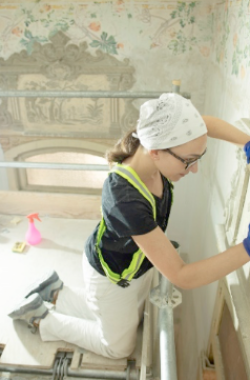
Behind the Scenes:
Meet Palazzo Spinelli
Constructed during the French colonial rule, Villa le Voile appears distinctly European. Inside, however, is a blend of indigenous Vietnamese and Chinese design elements – an amalgamation that reflects its first owner’s preferences and the different ways the villa has been used: as a family residence, as schools, and even as offices to members of the French army. From a stylistic point of view, the villa’s restorers describe the house as eclectic, owing to the hybrid of influences visible in its Vietnamese and Art Nouveau accents and Chinese wall paintings.
Palazzo Spinelli Institute for Art and Restoration, an Italy-based international group of companies that has restored over 18,000 works of art for museums, churches, and other institutions, focused on restoring the original layers of the villa, removing the overpainting, and the recovery of the remaining interior decorations. Here, we speak to key members of the team, Emanuele Amodei (President), Giacomo Dini, and Catherine Burnett.
Tell us about Palazzo Spinelli and how you were approached to work on Villa le Voile.
Emanuele Amodei: We are based in Florence, and the main scope of our group is conservation and restoration in all respects. We are an international group and have worked with different institutions around the world, such as Japan, South America, and now Vietnam. In Florence and Tuscany, since 1976, we’ve restored over 18,000 pieces of art including paper, paintings, canvas, relics, stones, mosaics, etc. We’ve worked inside museums, churches, institutional companies, and more.
Catherine Burnett: When we first got the brief for the villa, the first task was to hire staff in 2018. We had identified the phases of work, in accordance with the brief, which was to restore the original layers of the villa and discover what was underneath the overpainting. There would be two main phases: the first would be the removal of the overpainting, and the second would be the recovery of the restoration of the remaining decoration.

How did you approach the restoration of the villa’s frescoes?
Catherine: I’m going to take the analogy of any restoration project, whether it’s a painting or a building or a piece of furniture – it’s like a medical patient. It’s like a medical mystery – there is only so much you can know when you first see the outside. But when you start scraping away at the layers, that’s when the patient, to extend the analogy, starts telling you more.
Giacomo Dini: The approach was cognitive and analytical. We established different methods of intervention. There are different cases, room by room, point by point… we found different situations in every room. We used chemical and mechanical methods.

Giacomo and Catherine: The state of the villa is that of its organic nature. We’ve uncovered all the overpainting layers so we know exactly the decorative work is now. Our task at the minute is to save and stabilize what is there in terms of its adherence to the wall, and then strictly following a minimal intervention – so we are not repainting, we are restoring – we are trying to recover an impression of the decorative work. We retouch in undertones. We don’t use the same materials or same color tones as the original paint – we use an undertone which is to return an idea or impression of what the artist’s original intention was. A person visiting the villa should have the idea, feeling, or general impression of the original artist’s intentions. The technique is called minimal intervention. We are very sure that the atmosphere and feeling and the impression of the villa will create something that is extremely beautiful.

Why were you drawn to this project?
Emanuele: We have an international vision. Our institution was based on the fact that we strongly believe that transferring knowledge and competence in terms of conservation and restoration is something very connected… It is a methodology or philosophy. We saw the great potential of the villa. I see not the restoration or conservation itself but the meaning of this restoration. What I see in Vietnam is something more. I see a beautiful future for the country. Ho Chi Minh is a city that is growing, changing every day. It’s also important to give back to the people, and the idea is that when you enter the villa you will have a clear idea of the past. That is the philosophy behind our work. It’s not only a question of conservation and restoration, it is a question of giving to the future generation, the next generation – giving them an idea of the importance of cultural heritage.
***
About Palazzo Spinelli
The Institute works globally for the protection of world cultural heritage through promotion and management of initiatives based on the study, conservation, restoration and enhancement of historical and artistic heritage, and through projects carried out in collaboration with public and private entities, with the European Commission, UNESCO and the Italian Ministry of Foreign Affairs. The Institute works through a framework of agreements of Scientific, Technological and Cultural cooperation undersigned with more than 60 governments worldwide. Thanks to these activities, and participation in international projects funded by the European Commission, the Institute has established an extensive network of collaboration and partnership that includes over 500 institutions in 100 countries.


